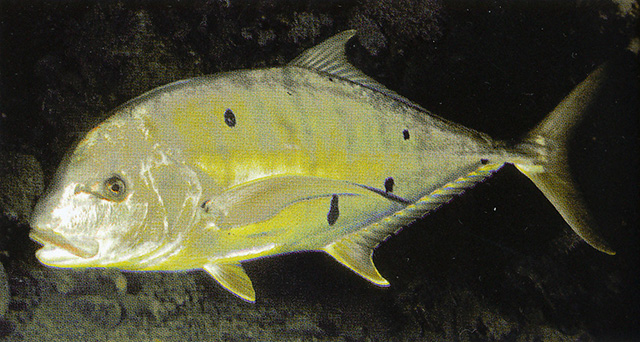| Carangidae (Jacks and pompanos), subfamily: Caranginae |
| 120 cm TL (male/unsexed); max.weight: 15 kg |
|
reef-associated; depth range - 80 m |
| Indo-Pacific: from Kwazulu-Natal, South Africa, north to Mie Prefecture, Japan and east to southwestern coast of Baja California Sur, Mexico and Gulf of California to Ecuador (Ref. 9283). |
|
Dorsal spines (total): 8-8; Dorsal soft rays (total): 18-20; Anal spines: 3-3; Anal soft rays: 15-17. Description: Juveniles and subadult bright yellow to silvery with broad and narrow black bars alternating; fins yellowish. Adults generally silvery grey with few black blotches or spots on sides and very faint bars, if present. Lips thick and fleshy; upper jaw strongly protractile. Breast completely scaled. (Ref. 2334, 90102) LL scutes 17-26 (Ref. 90102). Pectorals falcate; anal fin with 2 detached spines (Ref. 2334). |
| Adults occur in deep lagoon and seaward reefs where they feed by rooting for crustaceans and fossorial invertebrates in the sand but they also feed on small fishes (Ref. 9710, 90102). Small juveniles live among the tentacles of jellyfish (Ref. 9710). Adults form schools and are also noted for their behavior to closely swim around sharks and other large fishes, and also follow divers (Ref. 10361). Juveniles particularly display this piloting behavior to gain protection from likely predators (Ref. 9710, 90102). Marketed fresh and salted or dried (Ref. 9283). Juveniles are used in the aquarium trade. |
|
(Ref. 96402)
|
| harmless |
|
Source and more info: www.fishbase.org. For personal, classroom, and other internal use only. Not for publication.
Page created by Jen, 05.08.02,
php script by kbanasihan 06/09/2010 ,
last modified by
dsantos, 20/08/10

